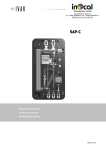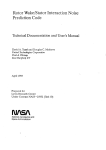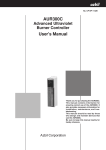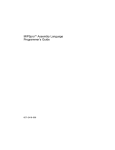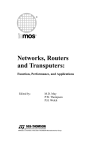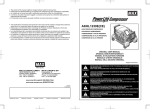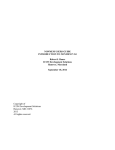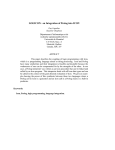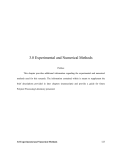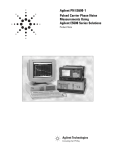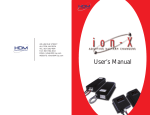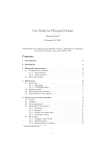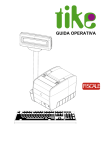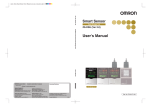Download PROPHET - PK/PD-Expertentreffen
Transcript
___________ User Manual PROPHET A free NONMEM User Interface for UNIX / LINUX by Dirk Zeumer aBcd © 2004 PROPHET - User Manual 1 1 2 3 4 5 6 Table of Contents Table of Contents ............................................................................................................... 2 Introduction ........................................................................................................................ 3 2.1 About PROPHET ....................................................................................................... 3 2.2 Terms of Usage .......................................................................................................... 3 2.3 Developments with PROPHET.................................................................................. 4 Installation.......................................................................................................................... 5 3.1 Prerequisites ............................................................................................................... 5 3.2 Running the Installation ............................................................................................. 5 3.3 Checking the Installation............................................................................................ 6 PROPHETs Conventions ................................................................................................... 7 4.1 Descriptors ................................................................................................................. 7 4.2 Initial Values .............................................................................................................. 8 4.3 Table Statements ........................................................................................................ 8 4.4 Plot Generation........................................................................................................... 8 Working with PROPHET................................................................................................. 10 5.1 Starting a NONMEM calculation............................................................................. 10 5.2 Actual Run Number & File Protection..................................................................... 10 5.3 Result Directories..................................................................................................... 10 5.4 Result Files............................................................................................................... 11 5.5 Reduced Data File .................................................................................................... 11 5.6 Adding Standard Plots.............................................................................................. 12 Examples .......................................................................................................................... 13 6.1 Example of Report ................................................................................................... 13 6.2 Example of GoF Plot................................................................................................ 14 Page 2 PROPHET - User Manual 2 Introduction 2.1 About PROPHET PROPHET is a package of tools developed by Boehringer Ingelheim Pharma GmbH & Co. KG (BI Pharma) with the intention to replace the NONMEM standard user interface and to offer additional benefits during the process of a population pharmacokinetic / pharmacodynamic evaluation of clinical studies with NONMEM. PROPHET offers the following functionality: • • • • • • • • 2.2 Full NONMEM integration Simultaneous execution of NONMEM calculations in the same directory Creation of a report file providing most important information for assessment of a run in a condensed way (see 5.3 and 6.1) Use of ‘descriptors’ in input and report files for easy documentation (see 4.1 and figure 1) Log file creation, containing all information and data of a NONMEM calculation (see 5.4) Configurable graphic generator for automatic generation of (i.e.) Goodness-of-Fit plots (see 5.5 and 6.2) Automatic use of subdirectory structures for table, GoF, error and log files in order to avoid “overcrowded” directories (see 5.4) Basic file protection to avoid accidental overwriting of result files (see 5.2) Terms of Usage The software and accompanying written material are provided “as is” without warranty of any kind. Further, BI Pharma GmbH & Co. KG does not warrant, guarantee, or make any representations regarding the use, or the results of use, of the software or written material in terms of correctness, accuracy, reliability, currentness, or otherwise. The entire risk as to the results and performance of the software is assumed by you. If the software or written materials are defective to you, and not BI Pharma GmbH & Co. KG or his agents, or employees, assume the entire costs of all necessary serving, repair, or correction. There are inherent dangers in the use of any software and BI Pharma GmbH & Co. KG cautions you to make sure that you completely understand the potential risks before installing and/or using the software. You are solely responsible for adequate protection and backup of the data and equipment used in connection with the software. The above is the only warranty of any kind, either express or implied, including but not limited to the implied warranties of merchantability and fitness for a particular purpose, that is made by BI Pharma GmbH & Co. KG, on this software. No oral or written information or advice given by BI Pharma GmbH & Co. KG, his agents or employees shall create a warranty Page 3 PROPHET - User Manual or in any way increase the scope of this warranty and you may not rely on any such information or advice. You may have other rights. Neither BI Pharma GmbH & Co. KG nor anyone else who has been involved in the creation, production or delivery of this software shall be liable for any direct, indirect, consequential or incidental damages (including damages for loss of business profit, and the like) arising out of the use or inability to use such software even if BI Pharma GmbH & Co. KG has been advised of the possibility of such damages. Acknowledgement By using this software you acknowledge that you have read this warranty statement, understand it, and agree to be bound by its’ terms and conditions. You also agree that this statement is the complete and exclusive statement of agreement between the parties and supersede all proposals or prior agreements, oral or written, and any other communications between the parties relating to the subject matter. 2.3 Further Developments / Additions to PROPHET PROPHET is completely written in PERL. Therefore, further development and/or additions to the software are relatively easy to implement. Those further developments and/or additions are highly encouraged by BI Pharma GmbH & Co. KG as far as the following points are considered: • please clearly state that the "new software" is based on PROPHET but is not (!) the original PROPHET itself. • please notify BI Pharma GmbH & Co. KG about such further developments and/or additions (send an email to: [email protected]). Page 4 PROPHET - User Manual 3 Installation This chapter describes the installation of PROPHET on your system. It is kept as simple as possible and reduces the user interaction to a minimum. Simply follow the instructions below. 3.1 Prerequisites The software requirements to be fulfilled to install PROPHET are: • • • Unix or Linux as operating system (OS) Perl 5.6 (or higher) – should be already installed on every Unix / Linux OS NONMEM additionally for the use of the automatic graphic creation: • 3.2 S-Plus 5 (or higher) Running the Installation • Create a new directory to install PROPHET into. Depending on the intended number of users of PROPHET on your system this directory can be located either in your home directory (single user) or in a free accessible directory (usually /usr/share). Note: It is recommended to install PROPHET only once on each system! • Copy the file PROPHET.tar.gz into the newly created directory. • Open a command shell, move into the directory and unpack the file using the following commands: gunzip *.gz tar xvf *.tar • Enter the following command: perl installer The installation will start immediately. In some cases the installation routine will ask for some input (usually asking for the position of some files or directories). Please enter your answer and press return for each question. Note: It is possible to stop the installation at every time pressing the CTRL-C combination on your keyboard. The installation can be restarted as often as necessary. Page 5 PROPHET - User Manual General note: In order to be accessible throughout the system, PROPHET needs “to be found” by the system resources. Usually this is done by adding the installation directory to the user’s PATH variable. The easiest way to do this is to edit the user’s environment set up file that resides in the user’s home directory (called .profile). As this file can have different syntax from user to user (depending on system and used shell type) no further explanation can be given here. Please contact your local system administrator or browse your system documentation. 3.3 Checking the Installation Beyond the installation directory an additional directory (called test) was installed. It contains a NONMEM control stream (run001.inp) and a data file (data1.dat) that can be used to test the installation as following: • Enter the directory on the shell • Enter the following command: ../nmSub run001.inp Note: It is assumed that you don’t have added the installation directory to your PATH variable so far. Otherwise you may skip the “../” in the command. • If PROPHET was successfully installed, four new directories (ERRORS, LOGS, TABLES, GOF) and a new file (run001.rep001) have been created. If during the installation you have chosen to use the automatic graphic creation routine you can also find a file called GOF001.ps beyond the newly created GOF directory, indicating that the link between PROPHET and the S-Plus package is working correctly. Page 6 PROPHET - User Manual 4 PROPHETs Conventions In order to work in the intended way, PROPHET requires some conventions to be fulfilled regarding the NONMEM control stream. These conventions are detailed in the subchapters below. 4.1 Descriptors In order to create a complete report that can be used as a reference for a finished NONMEM calculation, PROPHET expects additional details within the control stream – so called descriptors. A descriptor is implemented as a NONMEM comment, consisting of a keyword and a “content” or “value”, separated by a ‘:’. Syntax example: ;KEYWORD: Value All descriptors are expected to be found within the control stream before the appearance of the $PROBLEM statement and with a maximum length of 60 characters for their content. Most descriptors are mandatory for PROPHET but some are used as commands (see below). With two exceptions (NOTES and PLOT) all descriptors should be used only once as the second use of a descriptor will “override” the content of the first. The following descriptors are implemented in this version: Keyword Value Description Mandatory PROJECT Project name Name of project to which this control stream belongs Y STUDY Study number Number of study to which this control stream belongs Y RUN Run number Number of control stream Y KINETICIST Name or initials of pharmacokineticist Name or initials of pharmacokineticist that defined this control stream Y NOTES* Free text Any comment to this control stream N NOGOF -- Deactivates the automatic generation of the GOF plot for this control stream. N NOREPORT -- Deactivates the automatic generation of the report for this control stream N PLOT Plot name Activates the automatic generation of the given plot for this control stream** N * : this descriptor may appear as often as needed. Content will be merged in the report. Page 7 PROPHET - User Manual ** : the value of the descriptor has to match the defined name in the plot configuration file (see Adding Standard Plots) Note: Please don’t use a ‘:’ within the value of a descriptor – otherwise the descriptor value won’t completely appear in the report file. 4.2 Initial Values In order to make the automatically created report as readable as possible, PROPHET offers the possibility that the user will give reference names (10 characters max.) to the variables used in the control stream. As these reference names are implemented as NONMEM comments, PROPHET expects that every initial value for a variable is placed in a single line (regardless if you are using reference names or not!). The reference name is placed behind the initial value, separated by a ‘;’ from it. Example: $THETA (0, 0.02, ) ; CL 100 ; V2 $OMEGA BLOCK(2) 0.1 ; Eta_CL 0.1 ; Corr_CL/V2 0.1 ; Eta_V2 4.3 Table Statements PROPHET requires that all tables files that are created by the use of the $TABLE statement in your control stream are ending with the letters “tab”. Only table files corresponding to this requirement will be automatically transferred from the temporary working directories into the subdirectory structures and will receive the basic result file protection. 4.4 Plot Generation PROPHET will automatically call its graphic generation routine after the calculation of a NONMEM control stream (unless you aren’t using S-Plus or have used the NOPLOT descriptor in your control stream). In order to create the Goodness-of-Fit (GoF) plot from the results, PROPHET expects a certain kind of table as an output file from your calculation. This table file is called sdtab and is identical to the file specified by the S-Plus library Xpose. Page 8 PROPHET - User Manual From the Xpose 2.0 User’s Manual (page 7): “sdtab stands for standard table file. It should contain items describing the overall goodness of fit. The recommended column items and order for this table file is ID, TIME, IPRED and IWRES (in addition to these NONMEM by default adds DV, PRED, RES and WRES). IPRED (individual predictions) and IWRES (individual weighted residuals) are not NONMEM defined items and has to be defined by the user. These can be obtained by the following code in the $ERROR block: $ERROR IPRED = F W = ; Your choice: ; 1 = additive error model ; F = constant CV error model ; F**THETA(.) = power error model ; (F**2+THETA(.)**2)**0.5 ; = additive plus ; proportional error model IRES = DV-IPRED IWRES = IRES/W Y = IPRED + W*EPS(1) Note that the IWRES = IRES/W line will, in some cases, need reformulation to avoid division by zero.” This reformulation can be done by adding the following code (replacing the original IWRES=IRES/W line from above): DEL = 0 IF(IPRED.EQ.0) DEL = 0.001 IWRES = IRES / (W + DEL) Important note: When coding your $INPUT statement, please make sure that your dependent variable is called “DV” only (not “CP=DV” or something similar)! Otherwise NONMEM will add your dependent variable with its “original” name into the table file and the automatic graphic generator will fail (as it expects a DV column). Page 9 PROPHET - User Manual 5 Working with PROPHET 5.1 Starting a NONMEM calculation Once a control stream has been created it can be submitted with the following command (on the command shell): nmSub name_of_file Before passing the file to the NONMEM package, PROPHET will check the correct use of the descriptors and report any error on this topic on the screen (in this case further processing will be stopped). Further internal checks will be done in the background. If all checks have passed, the calculation will be started. 5.2 Actual Run Number & File Protection PROPHET will try to protect previous results from being overwritten when a user submits a control stream again without changing the file name (i.e. after changing the initial values). This will be done be adding the so called “actual run number” (ARN) as extension to the file names of all results (including table files!). In the beginning, the ARN equals the value of the RUN descriptor. Every time a control stream is submitted, PROPHET checks the existence of a log file for this control stream that ends with this value. If such a file exists (meaning that the control stream has been submitted before) PROPHET appends a “.x” to the ARN (and therefore to the file name). This ‘x’ is increased until a new, unique filename can be build. Example: Given a control stream name of “run001.inp” and a RUN descriptor value of “001”, the ARN will be: # of submissions 1st 2nd 3rd … 5.3 ARN 001 001.1 001.2 Result Directories In every directory from which nmSub is called, PROPHET automatically creates a set of subdirectories in which the result files of every calculation will be stored. These directories and their use for PROPHET are as follows: ERRORS GOF contains all error files contains all GoF plots Page 10 PROPHET - User Manual LOGS TABLES contains all log files contains all result table files The report file is stored in the same directory as the control stream. An example of a report and a standard GoF plot can be found in 6.1 and 6.2. 5.4 Result Files A control stream calculation will result in up to 4 result files and the table files specified in the $TABLE statements: Kind of File File Extension* Content log file .log[ARN] ASCII file containing all information about the calculation and its results in a single ASCII file (i.e. control stream, reduced data file, NM-TRAN output, NONMEM compile script, NONMEM output). report file .rep[ARN] ASCII file containing a condensed report of the NONMEM output. error file .err[ARN] ASCII file containing all relevant warning and error messages from the calculation (normally NM-TRAN output only). The “default” warning (“NM-TRAN infers that the data are population”) is not recorded. GoF file [ARN].ps PostScript file with the standard GoF plot. Needs a postscript viewer to be displayed on screen (like Ghostview). table file(s) tab[ARN] ASCII file(s) containing the information asked for in the $TABLE statement of the control stream. * : the expression [ARN] will be replaced by the value of the actual run number 5.5 Reduced Data File In order to use as less disk space as possible PROPHET will reduce the given data file for the calculation to the necessary minimum. This new data file, called “reduced data file” contains only those columns that are needed by NONMEM, skipping all columns that are dropped or not referred to in the $INPUT statement of the control stream (the $INPUT will be automatically adjusted). The reduced data file and the changed control stream will be used for calculation only (the original files remain unchanged!) and will be stored in the log file. Page 11 PROPHET - User Manual 5.6 Adding Standard Plots The automatic plot generator offers the possibility to include user written S-Plus scripts to the set of available plots. These plots need to be specified in the plot configuration file (nmPlot.cfg) residing in the installation directory. An entry in the plot configuration file has the following structure: [PLOT_NAME] Name that will be used as value for the PLOT descriptor in the control stream (case sensitive!). PLOT = /full/path Complete path to the script that should be run by S-Plus. DEPEND = table_name Name of table file(s) required by the script. Multiple file names have to be separated by a single blank. If any of the files are missing, the plot routine will not be called. TARGET = directory Name of subdirectory to which the plot will be stored. Page 12 PROPHET - User Manual 6 Examples 6.1 Example of Report -------------------------------------------------------------------------------Report for file : run001.log001 -------------------------------------------------------------------------------Project : Theophylline Study : 0815 - PROPHET Test Run : 001 Notes : Adapted version of the CONTROL5 file from NONMEM -------------------------------------------------------------------------------Kineticist : Demo User Input File : run001.inp Data File : THEOPP_red -------------------------------------------------------------------------------Subroutines : ADVAN2 Method : FO Records : 144 Observations : 132 Subjects : 12 Obj-Func. : 104.561 Evaluations : 193 Sig.Digits : 4.2 -------------------------------------------------------------------------------Gradient: .8295E-02 .2714E-01 -.5259E-01 .2081E-02 -.3910E-03 .9792E-03 .4103E-03 .1779E-02 .1210E-02 -.4317E-02 0MINIMIZATION SUCCESSFUL -------------------------------------------------------------------------------Parameter Description Initial Estimate STDerr %SE 95%-Interval (EST +/- 2x STDerr) THETA 1 : KA (.1,3,5) 2.7700 0.7080 25.56 1.3540 4.1860 2 : K (.008,.08,.5 0.0781 0.0073 9.30 0.0636 0.0926 3 : CL (.004,.04,.9 0.0363 0.0045 12.48 0.0272 0.0454 OMEGA 1 : ETA_KA : CORR_KA/K 2 : ETA_K : CORR_KA/CL : CORR_K/CL 3 : ETA_CL 6 .005 .0002 .3 .006 .4 5.5500 0.0052 0.0002 -0.1280 0.0091 0.5150 4.8300 87.03 0.0140 267.18 0.0001 50.83 0.4740 -370.31 0.0037 40.83 0.2120 41.17 -4.1100 -0.0228 -0.0000 -1.0760 0.0017 0.0910 15.2100 0.0332 0.0005 0.8200 0.0166 0.9390 SIGMA 1 : add. Error .4 0.3880 0.1050 27.06 0.1780 0.5980 -------------------------------------------------------------------------------$INPUT ID DOSE=AMT TIME DV WT $PK CALLFL=1 KA=THETA(1)+ETA(1) K=THETA(2)+ETA(2) CL=THETA(3)*WT+ETA(3) SC=CL/K/WT $ERROR IPRED=F DEL=0 IF(IPRED.EQ.0) DEL=0.0001 W=1 ; additive error IRES=DV-IPRED IWRES=IRES/(W+DEL) Y=IPRED+W*EPS(1) $COV $TABLE ID TIME IPRED IWRES ONEHEADER NOPRINT FILE=sdtab001 -------------------------------------------------------------------------------- Page 13 PROPHET - User Manual Example of GoF Plot • ••• • • •••••• • • •• • 0 10 8 • 0 • 2 PRED 6 0 2 4 • •• • • 2 4 6 DV 8 10 • • • • • • •• • • • ••• • • •••••• • • •• • 0 • • • •• • • • • •• • • • • • • • • • ••• • • • • • • •••••••• • • • •• ••• • • • • • •• • • • •• • • • •• •• • •• • • •• • • • • •• • • • • • • • IPRED 6 8 • • • • • • • •• • • • • •• • • • • • • • • • ••• • • • • • • •••••••• • • • •• ••• • • • • • •• • • • •• • • • •• •• • •• • • •• • • • • •• • • • • • • • 4 10 Goodness of Fit for Run 001 • 2 4 6 DV 8 10 -2 • • •• •• • •• ••• • • • •••• • • •• ••• • • • • • • • • • • • • • • •• •• •• • •• • • •• • • ••• • • • • • • • ••• • •• • •••• ••• • • •• • • •• • • • • • • • •• •••• •••• • • • • • • • •• • • • • • • •• • •• • • • • • • • • • •••••••• • 0 2 4 6 PRED 8 10 • • • •• • • • IWRES 0 2 • ••• •• ••• • • -2 •• •• • • • •• • • • • • • • • • • • •• ••• • • •••••••••• •• •••• •• • • • •• •• •• • • • • -4 2 • • WRES 0 • 4 • • 0 2 • 4 6 IPRED • • • •• •• ••• •• •• •• •• • • • •• •• •• • 8 • • • • •• • • 10 • •• • • • •• ••• ••• • • ••• • • • • •••• •• •• • •••• •• • • 0 5 10 15 TIME 20 25 •• • IWRES 0 2 • • • • •• • •• • •• •• •• •• -2 • •• ••• • •• •• • • •• ••••• •• • ••• • • • • •• • ••• •• • • -4 2 WRES 0 4 • • -2 6.2 • • •• • • ••• •• •••• • •• •• •• •• • • • • •• ••• • •• •• • •• • 0 • • ••• • • • •• • ••• • • 5 • 10 • • • •••••• 15 20 25 TIME Page 14














